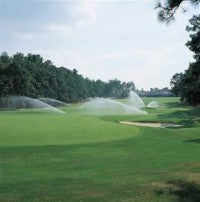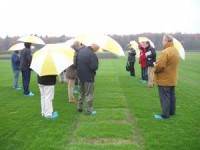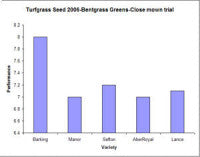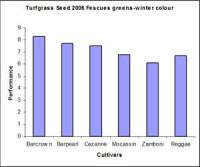Mixing it on the golf course
MIXING IT ON THE GOLF COURSE
Dave Saltman discusses the significance of grass seed mixture formulation withBarenbrug's Jayne Leyland.
Turf is a society of many plants in which there is always competition and co-operation. Have you ever considered why grass seed mixtures are formulated as they are? Current UK industry performance trials are carried out at the Sports Turf Research Institute (STRI) in accordance with the protocol of the British Society of Plant Breeders (BSPB), the results of which are published each year in the form of the Turfgrass Seed Booklet.

In the UK, cultivars are rarely used as a monoculture. They are more commonly used either in blends of one species or in mixtures of different species. Furthermore, these are often used for overseeding into an established sward which already contains several different species, rather than for new sowings. Mixtures and blends offer great benefits by combining a range of desirable characteristics which can enhance the health, aesthetics and performance of the sward.
Grass species - and cultivars within species - have different germination and establishment capabilities at varying soil temperatures and sowing depths. Maintenance practices and environmental impact also influences the species composition of the sward. This is why Barenbrug, as part of a continued investment in product development, has initiated a comprehensive and evolutionary mixture trials programme at Barenbrug Research Stations, golf courses and sports grounds throughout Europe. This is further supported by independent trials at the STRI in the UK.
The primary objective of the trials programme is to assess and evaluate mixture performance to ensure they offer the best possible solutions using their highly rated cultivars and innovative new species.
Mixture Formulation for golf greens
Many Greenkeepers still choose a mixture of fescues and bents for overseeding golf greens. This may be because the original greens were sown out with that particular specification, or it's perhaps difficult to apply bent grasses as a single species because the Greenkeeper's current equipment cannot be calibrated to apply very small bentgrass seed at low rates - the fescue seeds in the mixture merely acting as a 'carrier'.
An 80/20 fescue bent mixture actually contains about 50 per cent each of fescues and bents by volume, so consider which species you are able to establish in your particular greens so you do not potentially waste half your bag of seed before you start! Even if you are fortunate enough to be in a position where you are able to manage and maintain a balance of fescues and bents in your greens, think about the optimum maintenance requirements for the individual species.
| Mowing Height | N Input | Water Requirement | |
| Red Fescue | 6-7mm* | 40-80kg N | Very low |
| Festuca rubra spp. | per Ha per annum | ||
| Browntop Bent | 3-4mm | 100-200kg N | Medium |
| Agrostis capillaris | per Ha per annum |
*specific cultivars e.g. Barcrown can tolerate regular close mowing at 5mm
Consider also that fescues have superior wear tolerance to bents in drought conditions, and vice versa. Also remember the closer the mowing height the greater the stress!
Fescue/bent mixtures are formulated for construction, rather than renovation. Depending on your maintenance regimes - and rainfall - one species will dominate over the other in the sward, so to keep a balance you may decide to overseed with fescues and bents separately. The additional benefit of this is you can adjust your timing and sowing depths for optimum establishment of each species. BAR Fescue and BAR All Bent have been formulated specifically for this purpose. 
If you are trying to manage predominantly fescue/bent greens, you will know that the most vulnerable time is during winter play. Overseeding with BAR Fescue and BAR All Bent can help you maintain excellent winter aesthetics and performance through enhanced disease resistance and winter colour.
Why combine slender creeping red fescue (Festuca rubra trichophylla syn. litoralis) with Chewings fescue (Festuca rubra commutata) in a blend? Slender creeping red fescue has better colour during summer, autumn and early winter. It also has excellent salt tolerance and a rhizomatous growth habit. Chewings fescue has better colour during late winter and spring, has poor salt tolerance and a tufted growth habit. Combining the two sub-species provides better colour for longer. Fescue seeds are much larger than bentgrass seeds and for optimum germination should be sown 4-6mm deep into the rootzone, below the thatch layer.
BAR Fescue
Barcrown - outstanding winter green colour
Barpearl - excellent resistance to fusarium
Bargreen - superb tolerance of close mowing
BAR All Bent
BarKing - outstanding winter green colour and wear tolerance
Heriot - fine-leafed for excellent aesthetics

|

|
If you are on a parkland course with push-up greens that stay waterlogged for long periods during the winter, it is extremely difficult, if not impossible, to establish fescue in the sward. Fescue seed and seedlings cannot survive cold, wet soils. You can, however, dramatically improve the winter and early spring performance of your greens by overseeding with bentgrass, particularly if you regularly mow at heights below 5mm.
Poa spp. greens can and do present and play extremely well in the summer under normal maintenance inputs. The problems are in the autumn, winter and early spring when - unless you have the budget for preventative spraying - Poa is extremely susceptible to fatal diseases such as anthracnose and fusarium, resulting in poorly presented, uneven putting surfaces.
You can achieve success when overseeding with bentgrass and it is possible within a few years to convert predominantly Poa greens into predominantly bentgrass greens, with all the benefits this brings. For whatever reasons (usually lack of equipment and enforced maintenance windows), the main causes of poor results when overseeding with bent are surface sowing on top of thatch, sowing when the soil temperatures are too cold, or inadequate irrigation during the germination and early establishment period.
When choosing a bentgrass mixture, remember, you really do get what you pay for. Overseeding is an investment and whilst mixtures containing Highland bent (Agrostis castellana) are much cheaper than 100 per cent Agrostis capillaris mixtures such as BAR All Bent, consider this - Highland bent has poor shoot density, poor disease resistance, poor summer colour, poor wear tolerance and is broader leafed than cultivars of capillaris bent, often looking like a weed grass when mown at winter mowing heights.
Bentgrass seeds are extremely small and should be surface sown in good contact with the rootzone. When overseeding, the recommended sowing depths are BELOW any thatch layer; the seed must always be in good contact with the rootzone to have a chance of establishing successfully, so try to work as much seed as possible through the thatch layer by whatever means you have available (micro-tining, verticutting, thatchaway units, sarrel rolling etc).

The implications of close mowing heights can be overcome if you are able to sow the bentgrass seeds below the thatch layer in good contact with the rootzone. This protects it from mower blades and foot traffic and also helps to prevent drying out; adequate irrigation is critical at this time. By applying bentgrass seed at very low sowing rates over a period of three or four months, you will be able to significantly increase the percentage of desirable bentgrass in the sward, with all the benefits this offers. You will also have faster sward recovery at this time, reducing disruption to play. Light quality and day length is far better at this time of year for rapid, healthy plant growth.
Perennial ryegrass (Lolium perenne) is increasingly being used for overseeding golf greens on parkland courses and for bowling greens. Rapid germination, establishment and winter growth mean successful renovation can be achieved outside the usual window. An excellent surface during winter play is achievable, and disease scars can be repaired.
Remember, cultivar selection is extremely important, as characteristics vary greatly. Fineness of leaf and tolerance of close mowing are essential for this application. If your greens do not become too waterlogged during the winter, then BAR Platinum, a mixture of fine-leafed ryegrass and red fescue, can be used. The seed size of these two species means you can achieve successful establishment by sowing them together at the recommended depth of 4-6mm.
Warmer soil temperatures will help the fescue to compete alongside the ryegrass. For cool soil temperatures consider BAR Extreme. All the cultivars contained in this 100 per cent perennial ryegrass blend are fine-leafed and can tolerate regular close mowing down to 5mm, with occasional mowing down to 4mm.
Whatever grass seed mixture you are using, it is recommended to apply fertiliser AFTER the new seedlings have germinated. If you apply fertiliser pre-germination you are helping the existing, undesirable grasses in the sward to compete against the emerging new seedlings.
Successful overseeding means considering a whole raft of factors. Seeds need water, air and appropriate temperature to germinate and establish. Don't allow the seed or seedling to dry out. Think about seed size, the recommended sowing depth below the thatch layer is critical for optimum germination. Pre-seed preparation and appropriate maintenance practices are essential for optimum performance. Think about the synergy of species and cultivars within the mixture. Also think about timing, summer light quality and day length will help with establishment and recovery.
Jayne said, "Barenbrug is passionate about grass and we are dedicated to helping you achieve a quality of sward performance and presentation of which you can be proud. So, whatever motivates your grass seed selection, please give a thought to the breeding, research and trials which we undertake to offer you the best possible solutions".
All recommended sowing depths for each mixture can be found in the 2006 Barenbrug BAR Range catalogue.
For further information please telephone 01359 272000 or visit www.barenbrug.co.uk
